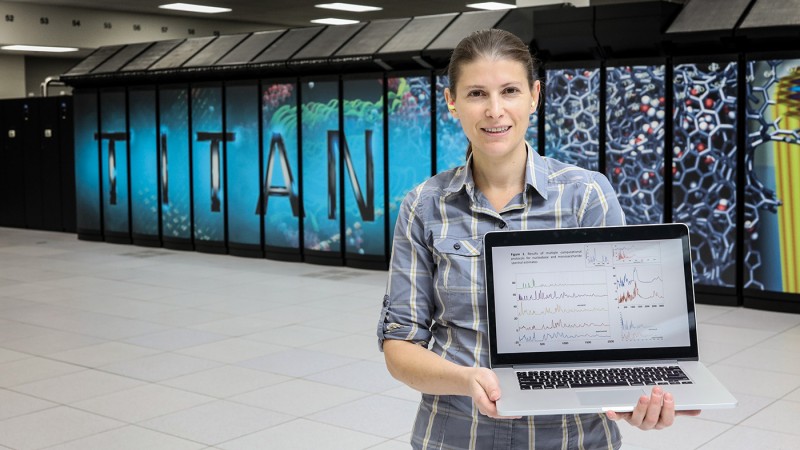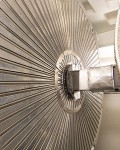Ada Sedova of the Scientific Computing Group is comparing molecular simulations with new data from neutron scattering
Ada Sedova, a postdoctoral research associate at the US Department of Energy’s (DOE’s) Oak Ridge National Laboratory (ORNL), tries to spend quality time away from her computer screen—where she is programming code for next-generation supercomputers—to work hands-on with experiments in the lab.
“I wanted to find a postdoc position where I could do experiment, computing, and theory. I wanted all the pillars of science in my life,” Sedova said.
At ORNL, Sedova works for the Oak Ridge Leadership Computing Facility (OLCF), a DOE Office of Science User Facility and home to Titan, the nation’s most powerful supercomputer. On Titan, scientists model the complex behavior of materials, among many other scientific problems.
As part of the OLCF’s Scientific Computing Group, Sedova is developing a portable library of non-bonded force calculations for GPU-enabled molecular dynamics codes, which are commonly used to simulate materials and biomolecules. The non-bonded forces—which span short and long distances to hold together atoms in a material—often take the longest amount of time to compute within a molecular dynamics application, creating a bottleneck in large-scale simulations with many thousands to millions of molecules.
“To get good performance on GPUs, you have to code in CUDA [a programming interface for parallel computing with GPUs], which is very manual,” Sedova said. “If you need to change architectures, then you have to change the code some. We’re trying to create a high-level interface so you don’t have to depend on the specifics of the machine.”
As a research associate, Sedova has also designed her own research project with the goal of improving theoretical descriptions of biomolecules used in computation by gathering new information from experiments. Although experiment and computation run parallel in many laboratories, with computer models informing experiment design and experiment data improving the accuracy of the models, it is less common for a single researcher to dive into both disciplines.
At ORNL, Sedova found she had access to two of America’s top research tools on the same campus.
Best of both worlds
While working on the 27-petaflop Titan, Sedova also conducts research at the nation’s most powerful pulsed neutron source, where scientists observe and measure the properties of materials by probing them with beams of neutron particles.
On the VISION vibrational spectrometer at ORNL’s Spallation Neutron Source (SNS), also a DOE Office of Science User Facility, Sedova collects data on the vibrational frequencies (or the motion of atoms within a molecule) of nucleic acid (DNA and RNA) components, including the five natural bases and the sugars that help give nucleic acids their flexible structure. By measuring these frequencies, VISION reveals information about molecular bonds and interactions that Sedova is using to improve quantum mechanics calculations for molecular dynamics codes. With more accurate quantum mechanics calculations, researchers can virtually explore a range of conditions affected by intramolecular bonds that are important to pharmaceutical and materials science.
“VISION is the world’s highest resolution vibrational spectrometer,” Sedova said. “This high resolution is captured especially well at the low (far-infrared) frequencies, which is an important region where nucleic acids and other biomolecules move in the concerted, cooperative motions of macromolecules, which are fundamental to processes in the cell.”
For instance, in the experimental data, she can see a puckering motion that occurs in the sugar molecules, found when DNA changes from “A Form” (a dehydrated form of DNA) to “B Form” (the form most often found in cells). This transition is important to genetics and often lost in both experimental data and computational modeling.
“Intramolecular experimental data improves modeling because it tells you how molecules like to interact. The quantum vibrations being measured show how molecules naturally move. Vibrations and frequency are a more rigorous way of checking quantum mechanical calculations compared to other methods,” she said.
The majority of molecular dynamics simulations today depend on classical physics calculations that make assumptions backed by experimental data. However, more powerful computers like those at the OLCF allow for codes to bridge the gap between classical physics and the complicated world of quantum physics, in which a multitude of subatomic forces organize a system of atoms. Improving how quantum mechanical calculations are integrated into the models is an important step.
To that end, both experiment and computation must be pushed to the limit, and Sedova sees a lot of opportunity to fuse the two disciplines to meet this goal.
“With neutron scattering, you’re seeing the response of each atom in the molecule. It’s a perfect synergy between experiment and computation,” she said. “We can learn whether our computational calculations are showing what these atoms are actually doing.”
Looking for answers
Measuring the vibrations of nucleic acid bases to improve molecular dynamics simulations is just the latest of Sedova’s research to bridge experiment and computation.
Before starting her undergraduate studies, Sedova went to nursing school: “The whole time I was in nursing school, I was asking questions the teachers couldn’t answer. They said I needed to ask a doctor.”
To find answers to her questions, Sedova enrolled in undergraduate premedical courses after finishing nursing school. While studying to be a physician, she ran into more and more questions that required mathematical solutions.
“I took a class called mathematical modeling, which used linear algebra, and I also saw in my advanced chemistry classes that there’s a huge amount of hardcore math in organic and physical chemistry. I wanted to go to medical school, but I also wanted to learn more applied math and chemistry,” she said.
She picked the closest thing to doing both that she could and went to graduate school for math and the biomedical sciences at the University of Albany, where she studied as a computational scientist in several US Department of Health laboratories.
While studying nuclear magnetic resonance, in which nuclei are probed with a magnetic field to reveal their structure, Sedova found an opportunity to combine computational and experimental work. She took a physics class in magnetic resonance so she could understand and code what was happening during the experimental setup into the models. During her doctoral research, she focused on nucleic acids, computing advanced free-energy calculations from molecular dynamics simulations and writing machine learning algorithms to search and identify patterns in DNA and RNA stacking, or how their bases and backbones coalesce and form.
When Sedova arrived at ORNL, she wanted to continue to find ways to address gaps between experiment and computation.
“There’s so much going on at ORNL, so much incredible science, that there was a higher chance that I could do experimental work while still being able to work in computing and simulation,” she said.
At a poster session, she met Timmy Ramirez-Cuesta, Spectroscopy Group lead at SNS, who was presenting on quantum molecular dynamics research conducted on spectroscopic instruments at SNS.
“I did not have a lot of experience with neutron scattering, but I had the spectroscopy background. There was a grant proposal due in 2 weeks, and I wrote the proposal in time,” she said, explaining that she decided to focus on the topic of her dissertation: nucleic acid building blocks and base stacking.
Now that she has studied some of the components of DNA and RNA on VISION, she is working with members of the Spectroscopy Group to collect data on larger molecules such as nucleotides (larger units of DNA bases connected to the sugar and phosphate backbone).
“I’m trying to build [the samples] up,” she said. “It would be nice if, one day, we could have a database of these vibrational neutron spectra for the world to look at.”
Oak Ridge National Laboratory is supported by the US Department of Energy’s Office of Science. The single largest supporter of basic research in the physical sciences in the United States, the Office of Science is working to address some of the most pressing challenges of our time. For more information, please visit science.energy.gov.--by Katie Elyce Jones





